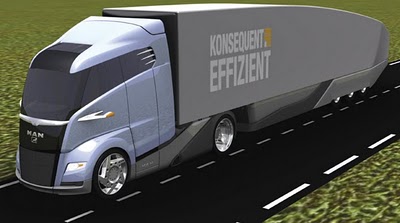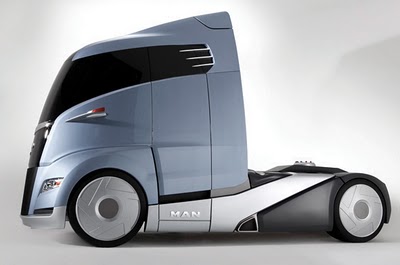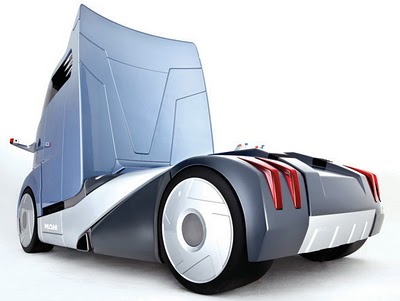 Slim front end, projecting wheel arches, a cab with soft, smooth lines and a curved rear wall: with its streamlined design, the MAN Concept S differs radically from the basically cubic shape of the conventional truck currently to be seen on the motorways. The design of the MAN Concept S was rigorously adjusted in the wind tunnel until its extremely low air resistance was attained. With its drag coefficient (cD value) of around 0.3 the MAN Concept S enters a domain of aerodynamic quality previously inhabited only by modern passenger limousines.
Slim front end, projecting wheel arches, a cab with soft, smooth lines and a curved rear wall: with its streamlined design, the MAN Concept S differs radically from the basically cubic shape of the conventional truck currently to be seen on the motorways. The design of the MAN Concept S was rigorously adjusted in the wind tunnel until its extremely low air resistance was attained. With its drag coefficient (cD value) of around 0.3 the MAN Concept S enters a domain of aerodynamic quality previously inhabited only by modern passenger limousines.Thanks solely to its aerodynamic form, the MAN Concept S – with an appropriately modified trailer – uses up to 25 per cent less fuel than a comparable, conventional 40-tonne semitrailer tractor. At the same time, this fuel saving also means a reduction of up to 25 per cent in CO2 emission. The MAN Concept S manages to do all this while providing the same amount of space for its driver as he has always been used to and the same loading capacity as a conventional truck. “Our Concept S in conjunction with an aerodynamically optimised semitrailer is as streamlined as a modern passenger car. We proved it in the wind tunnel. The savings in consumption are absolutely realistic,” says Holger Koos, head truck designer of MAN Nutzfahrzeuge.
The MAN Concept S is an advanced development of MAN’s so-called dolphin truck, which was presented to the trade as a simulation model at the IAA 2008. With its dolphin truck, MAN Nutzfahrzeuge produced initial proof of the maximum aerodynamic potential of a radically new semitrailer tractor design, a design-based on the flow topology of the dolphin. The designers deliberately ignored the existing European road infrastructure: the dolphin truck exceeded the height restrictions currently applicable to commercial vehicles in the EU by 20 centimetres. But Europe’s existing bridges, subways and tunnels are no obstacle to the MAN Concept S presented at the IAA 2010. The truck study complies exactly with the 4.00-metre height restriction and despite doing so, still matches the dolphin truck’s 25-per cent savings potential in terms of consumption and CO2 emission. This was achieved by consistently advancing the development of the streamlined shape. In the Concept S, the truck’s frame and components such as the two fuel tanks, for example, have been integrated into the external bodywork design where they help to guide the flow of air past the truck. One would search in vain for conventional rear-view mirrors on the MAN Concept S – their function has been taken over by cameras built into the wing-like mounts for the indicator units left and right. An electronically adjustable spoiler is integrated in a form-fitting manner into the roof of the driver’s cab.
But Europe’s existing bridges, subways and tunnels are no obstacle to the MAN Concept S presented at the IAA 2010. The truck study complies exactly with the 4.00-metre height restriction and despite doing so, still matches the dolphin truck’s 25-per cent savings potential in terms of consumption and CO2 emission. This was achieved by consistently advancing the development of the streamlined shape. In the Concept S, the truck’s frame and components such as the two fuel tanks, for example, have been integrated into the external bodywork design where they help to guide the flow of air past the truck. One would search in vain for conventional rear-view mirrors on the MAN Concept S – their function has been taken over by cameras built into the wing-like mounts for the indicator units left and right. An electronically adjustable spoiler is integrated in a form-fitting manner into the roof of the driver’s cab.
With its Concept S, MAN makes a contribution to the current socio-political discussion of possible reforms to the statutory length restrictions applying to commercial vehicles in Europe. In order to realise the efficiency potential proven by the Concept S, tractors and trailers will require more space along the horizontal axis if they are going to provide the same amount of interior space and loading volume as current tractors and trailers do. Changes to the road infrastructure for this purpose will not be necessary.
The aerodynamics of commercial vehicles
Aerodynamics has great potential for a further reduction of the fuel consumption and CO2 emission of commercial vehicles. If we look at the energy expenditure of a 40-t semitrailer tractor travelling on the level at 85 km/h, we see that rolling and air resistance are the decisive factors. Forty per cent of the energy is used in just overcoming air resistance. A reduction in air resistance was reached in 2007 with the introduction of the new MAN TGS and TGX heavy truck series. By comparison with the predecessor model, the TGA, the cD value was reduced by 4 per cent, even though the basic structure of the vehicle and cab were not changed. With their drag coefficients (cD) of around 0.5, conventional forward control trucks have reached a level of aerodynamics that can hardly be improved any more under the existing statutory restrictions on maximum permissible dimensions. Major improvements in reducing air resistance will only be possible when the restrictions on maximum dimensions permitted by law are loosened or replaced by alternative regulations. In the US, for instance, the length of the vehicle itself is not limited, only the size of its usable cargo bay.
With their drag coefficients (cD) of around 0.5, conventional forward control trucks have reached a level of aerodynamics that can hardly be improved any more under the existing statutory restrictions on maximum permissible dimensions. Major improvements in reducing air resistance will only be possible when the restrictions on maximum dimensions permitted by law are loosened or replaced by alternative regulations. In the US, for instance, the length of the vehicle itself is not limited, only the size of its usable cargo bay.
There will be a significant decrease in the amount of energy needed per transported tonne or cubic metre only if the loading volume is maintained along with aerodynamic optimisation. And this is precisely what the Concept S and a matching trailer achieve.